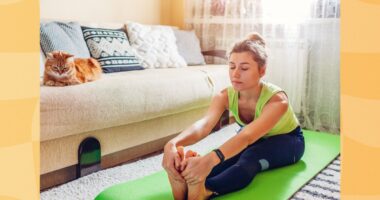Using the Eight Sleep app, I can set a specific schedule that changes while I sleep via the Temperature Dial. The temperatures span from -10 (deemed extremely cold by the app) to +10 (extremely hot). At my set bedtime, I program the bed to feel -5 (very cold). It shifts to -3 (cold) during my earliest hours of deep sleep, then to -2 (cool) during my last few hours of sleep, and warms to +1 around 8:30 a.m. (the wake-up time I set). I don’t sleep with another person, but if I did, I love that they could set their own schedule separate from mine.
Since I have the 8+ Pro membership (more on that below) I have an additional feature called Temperature Autopilot. The Autopilot takes my sleep patterns, biometrics, and room temperature into account to design a personalized schedule for me that adjusts over time. When my bedroom grew warmer during the summer, the app tweaked its temperatures. This add-on is not a must-have, but I appreciate knowing that the feature changes the Cover’s temperature without my oversight (useful for nights when my window AC shuts off after a few hours and the room warms).
Within days of using the Cover, I stopped waking in the night to turn on the fan or strip layers of clothes off. And on chillier days, I didn’t need to hunt for another blanket because my mattress was already toasty warm.
Health and Sleep Tracking
I’m not a huge fan of wearing fitness trackers because I don’t enjoy having a piece of tech attached to my body. Therefore, it’s great that the Pod Pro Cover keeps an eye on my biometrics without requiring me to strap on anything. The Eight Sleep app has a tab for its Sleep Report as well as a Health Report.
Within the Sleep Report, I can look at graphs tracking how much time I slept, time it took me to fall asleep, my wake-up time on average, and how long it takes me to wake up. I can also view my sleep stages, sleeping heart rate, and how many times I tossed and turned. On one recent night, for instance, I spent 26% in REM sleep (the dreaming stage of sleep, crucial for my brain and memory), 58% in light sleep (when I could easily be awakened), and 16% in deep sleep (when it’s hardest to wake me). I turned seven times and my heartbeats per minute ranged from 49 to 60. These stats are all collected and averaged out in charts per day, week, month, and year, with info explaining why each metric is useful—a fascinating insight into my sleep patterns.
READ RELATED: Covid-Flu Combined Booster Shot Possible Late 2023: Moderna
Separately, the Health Report tracks my heart-rate variability, sleeping heart rate, and sleeping respiratory rate. If my HRV is lower than usual, the app asks me whether I’m feeling well or if I’m pushing myself too hard and might need more recovery time. The same would occur for the other metrics should they fluctuate too far beyond what’s normal for me.
App Features (GentleRise, Sleep Content)
Instead of a blaring alarm, the Pod Pro Cover’s unique GentleRise alarm gradually vibrates the active grid to wake you. This would be helpful if I had a partner who wakes at a different time than me, as it would quietly urge only my side of the bed to wake. However, it’s still a pleasant, gentle way to wake instead of my phone’s alarm. It feels like a warm buzzing below me, and I can adjust the intensity and timing of the vibration in the app. Plus it really works, and I imagine would be an excellent way to wake if you’re an especially deep sleeper (or if you sleep with earplugs, as I do).
Source: SELF




.jpg)







